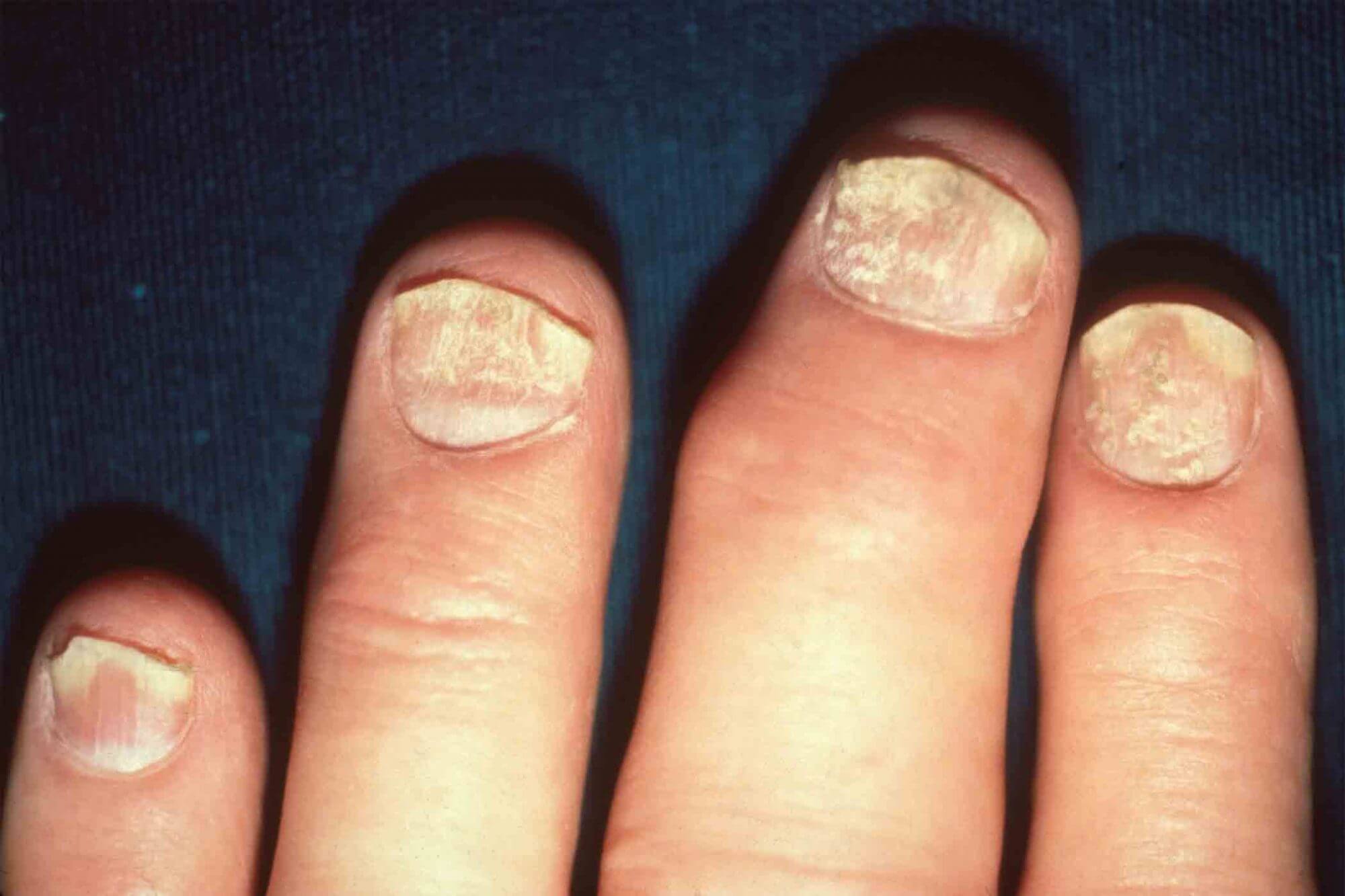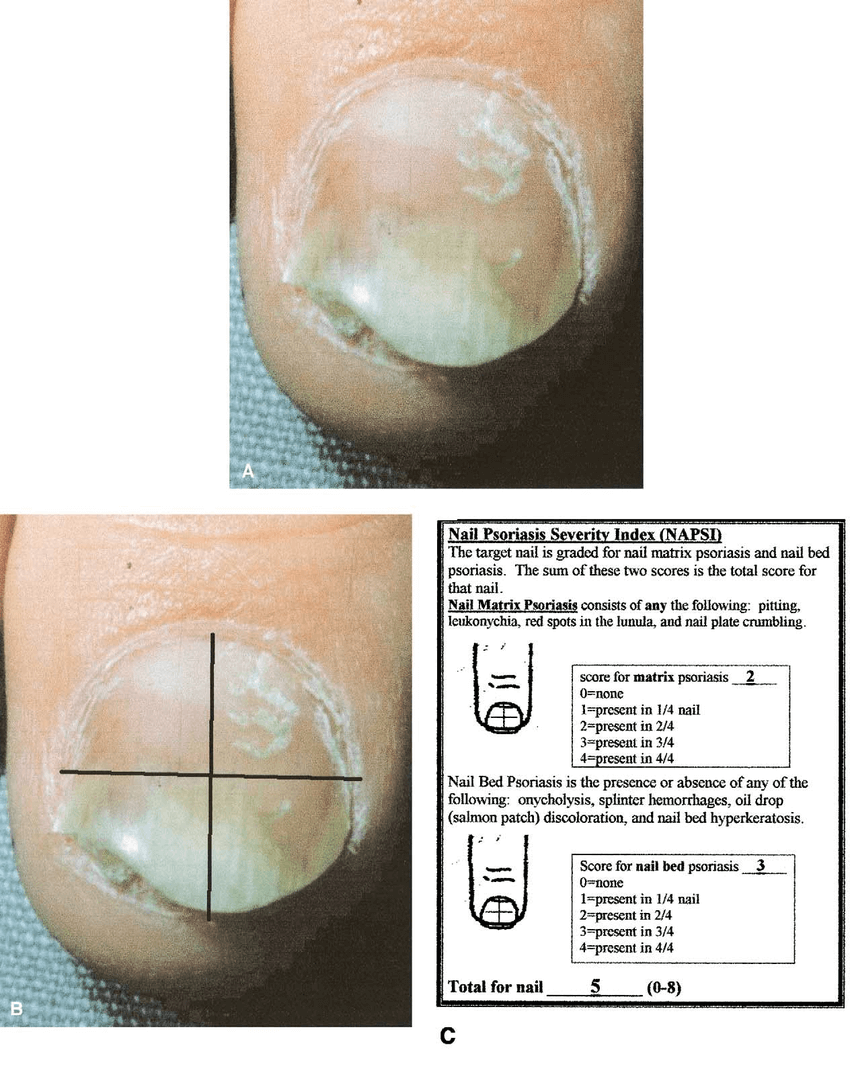No. There is no cure for nail psoriasis. Depending on the severity of the disease, nail psoriasis treatment can prove to be a laborious effort that may take very long before it yields desired results.
Page Contents
Nail Psoriasis: What Causes It?
When psoriasis affects hands or toenails, doctors speak of nail psoriasis. About 80-90% of all plaque psoriasis patients develop nail psoriasis.
If the joints also become inflamed as part of psoriasis (psoriatic arthritis), psoriatic nail changes are even more prevalent.
Nail psoriasis on its own rarely occurs (around 5 percent).
Psoriasis is an inflammatory skin disease. As far as researched so far, the immune system turns against the body’s own cells, resulting in inflammation. Psoriasis is therefore an autoimmune disease.
In nail psoriasis, inflammatory processes take place mainly in the nail bed and in the nail matrix, from which the visible nail part is created. This is fused with the skin underneath, the nail bed. If the nail bed and nail matrix change pathologically, the shape, structure, and color of the nail (nail plate) also change.
Acute nail psoriasis
In the acute form, psoriasis primarily inflames the ends of the fingers, but often also the entire finger, and the nail becomes deformed. The affected fingernail or toenail sometimes comes off completely. Acute nail psoriasis often hurts severely.
Chronic nail psoriasis
Nail psoriasis is more often chronic. The nails slowly change due to inflammatory processes. They can affect the nail matrix, the nail bed, and the nail fold. Since a nail grows rather slowly, the nail changes are also visible for a long time.
How do I recognize nail psoriasis?
Nail psoriasis can occur on just one or more nails at the same time, both on the hand and on the foot. Psoriasis on the fingernail or toenail can express itself very differently. Some people have multiple nail changes at the same time, others only have a single symptom.
It becomes more difficult when only the nails are abnormally changed. In this case, the doctor must differentiate nail psoriasis from other nail diseases, for example from lichen planus (here usually a thinned nail plate) or from eczema nails (with frequent or chronic rashes on the hand).
Nail fungus or nail psoriasis?
The distinction between nail psoriasis and nail fungus (onychomycosis) can be particularly tricky because the nail changes are similar. Yellowish discoloration of the nail or a thickened nail plate often occurs. The nail peels off or in some cases disintegrates, both in nail psoriasis and in fungal infections.
Symptoms of Nail Psoriasis
Psoriasis affecting the nail matrix is:
- Pitting of the nails
With this symptom, the nail plate has point-like indentations, which are usually no larger than a millimeter, and is known as nail pitting. There are usually several such depressions, also called dimples, on an infected nail. About three-quarters of psoriasis patients have pitted nails. They are the most common psoriatic nail lesion. - Red spots in the lunula
Red spots in the nail crescent (lunula) can also indicate psoriasis of the nails. - White spots on the nail plate (aka leukonychia)
Sometimes nail psoriasis shows up as white lines or spots on the nail plate (leukonychia). Leukonychia most commonly is caused by injury to the nail. - Nail plate crumbling (aka subungual hyperkeratosis)
With crumbling nails, the nail plate of the affected finger disintegrates. It is a particularly severe form of psoriasis of the nail, in which skin cells accumulate between the nail bed and the nail plate, destroying the actual nail structure. Crumbling nails arise when psoriasis affects the nail matrix and nail bed at the same time.
Psoriasis manifesting in the nail bed:
- Oil-drop stain
The most well-known discoloration of psoriasis on the nails is oil stains. The nails are then discolored yellowish to brownish in places. Oil stains occur when the nail bed is inflamed and skin flakes start to form under the nail plate. The nail psoriasis picture below is courtesy rheumatology network.
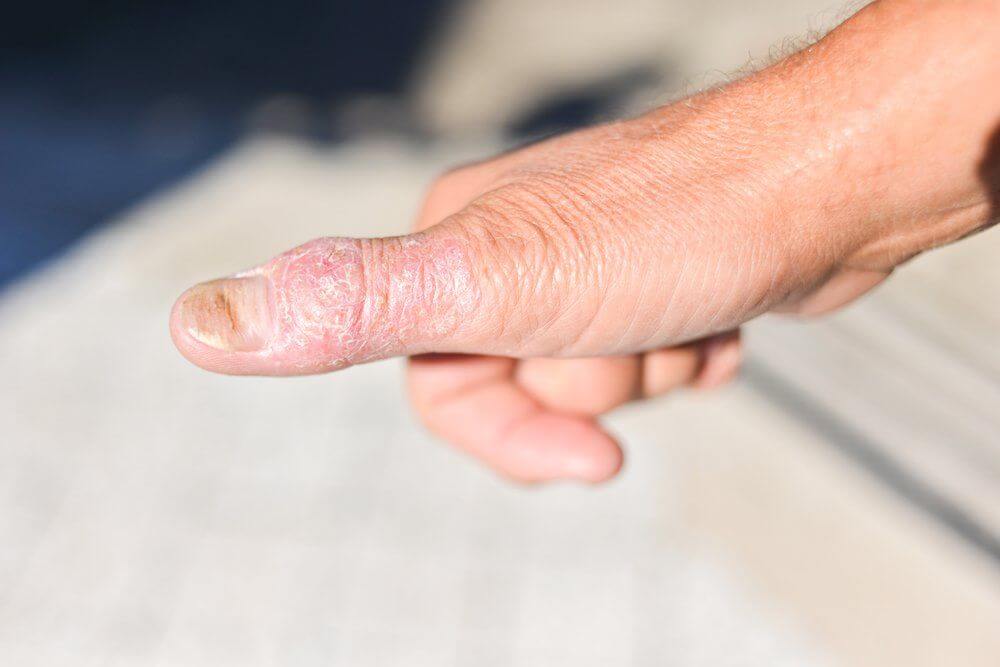
- Onycholysis
Nail bed separation (onycholysis) happens when inflammation of the nail bed causes severe flaking, resulting in the nail plate often coming off partially or completely. Doctors then speak of partial or total onycholysis. This affects around half of nail psoriasis patients. - Hyperkeratosis (aka subungual hyperkeratoses)
Subungual hyperkeratoses are caused by the accumulation of keratotic cells. The infestation of the entire nail matrix can lead to the complete destruction of the nail plate and to onychodystrophy (deformity of a nail) - Splinter hemorrhage
Doctors call fine bleeding in the nail bed fragment hemorrhage. They shimmer as thin, elongated, and, depending on the bleeding age, red, red-brown to blackish lines through the nail plate. Split hemorrhages grow with the nail. When they reach the front edge of the nail, they can be easily removed. - Nail fold psoriasis
Psoriasis can also affect the skin around the nail. Then one speaks of a nail fold psoriasis. It also often leads to changes in the nail, even if the nail itself is not affected. The nails are strongly corrugated or usually have transverse thickenings. These symptoms can also be seen with nail psoriasis.
Consequences of nail psoriasis symptoms:
Pain
In severe cases, psoriasis of the nails can be painful, especially when walking and grasping. The nail psoriasis then hinders sufferers in many activities, be it at home, in their free time, or at work. The quality of life is severely restricted.
Psychological stress from nail psoriasis
Pitted nails, oil stains, or onycholysis are psychologically very stressful for many sufferers because damaged or discolored fingernails are quickly associated with inadequate personal care. Therefore, patients with nail psoriasis often try to hide fingernails and hands as much as possible.
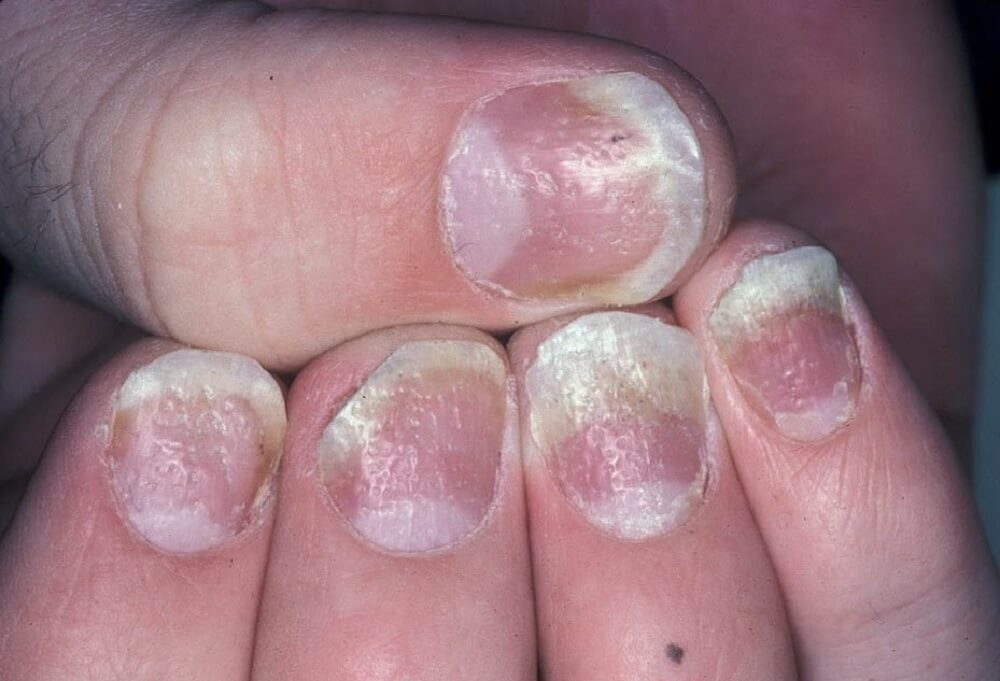
Nail Psoriasis Treatment
Severity scores
Over time, experts have developed various so-called scoring systems to record the full extent of nail psoriasis. The result of the scores is a numerical value. This illustrates how seriously ill people are affected and how much their quality of life suffers from nail psoriasis.
With the result of such a score, the doctor can often more easily determine how he would like to treat nail psoriasis. In addition, regular calculations help to monitor the course of the disease.
- Nail Psoriasis Severity Index (NAPSI)
It is a simple tool used to evaluate how severe the nail matrix and nail bed psoriasis by area of involvement in the nail unit is. It is very helpful in determining the best nail psoriasis treatment option to use.
Photograph A shows a psoriatic nail for grading. B: The nail is divided into quadrants, and each quadrant is evaluated for nail matrix and nail bed psoriasis. C: Instruction and grading form for grading psoriatic nails with the Nail Psoriasis Severity Index (NAPSI) (NAPSI scoring for A and B).
- Nail Psoriasis Quality of Life (NPQ10)
Another nail psoriasis score is the NPQ10 (Nail Psoriasis Quality of Life). Here it is calculated how much the nail psoriasis worsens the quality of life of an affected person. The doctor will enquire about your pain. He also asks to what extent you are restricted in your everyday life by nail psoriasis.
- Nail Assessment in Psoriasis and Psoriatic Arthritis (NAPPA)
The NAPPA-Score (Nail Assessment in Psoriasis and Psoriatic Arthritis) is the newest system. It is well researched and used worldwide. The NAPPA is the only system that takes into account both the severity and the everyday limitations of nail psoriasis.
Nail psoriasis treatment is laborious and requires a lot of patience. Psoriasis nail treatment can last for several months in severe cases. Nail psoriasis often does not go away completely despite treatment. Some mild forms can respond well to a number of topical agents.
Systemic agents are only used in severe forms of nail psoriasis in which skin parts and/or joints are also seriously affected.
The best treatment for nail psoriasis is to, first of all, consult a dermatologist.
Nail psoriasis treatment options include therapies that are either topical, intralesional, and systemic in nature. Which one you choose depends on the one hand on the nail status, i.e. how much the nails have changed due to psoriasis. On the other hand, it also depends on how much the disease burdens the patient.
The doctor also checks whether, for example, previous illnesses speak against the use of some active ingredients. The desire to have children also influences the choice of therapy, since many drugs cannot be used during or before a planned pregnancy.
How to treat nail psoriasis
Topical Treatment Options For Nail Psoriasis
In the case of mild forms of nail psoriasis, in particular, the doctor usually chooses topical therapy.
Among other things, creams, ointments, solutions, plasters, or varnishes that have been mixed with one or more active ingredients are used.
Any external nail psoriasis cure, in particular, is usually very time-consuming. This is because the active ingredients in topicals hardly or only very poorly penetrate the nail plate.
Sometimes it helps to soften the nail plate beforehand. It takes a long time for the healthy nail to grow back. You often only see the first successes after many months of consistent use.
Examples of topical treatments for nail psoriasis:
- Corticosteroids. The most commonly used agents are corticosteroids, often in combination with vitamin D3
- Urea (usually 15% concentration, in severe cases 40%. Serves to soften the nail plate to enable the medication to reach the nail bed)
- Vitamin D3 (calcipotriol)
- Nail lacquer (water-soluble nail lacquer containing hydroxypropyl chitosan (HPCH), horsetail extract (Equisetum arvense) and methylsulphonyl-methane (DMSO(2)). Source
- Tazarotene gel and cream (acetylenic retinoid related to Vitamin A and affects the growth of skin cells)
- 5-FU 5-fluorouracil (used in combination with urea or salicylic acid, improves symptoms such as oil spots and subungual hyperkeratosis)
- Tacrolimus (a topical calcineurin inhibitor (TCI), that has skin-penetrating capacities showing promise in one study)
- Ciclosporin (has immunosuppressive properties)
- Potent corticosteroids (betamethasone dipropionate 0.05% or clobetasol propionate 0.05% is very effective in treating onycholysis and subungual hyperkeratosis)
The preparations are often combined with salicylic acid in concentrations of 10 to 20%. Salicylic acid is able to soften the nail plate.
Other External Options Used to Treat Nail Psoriasis
- Cortisone injections: The doctor can also inject the cortisone around the nail matrix and under the nail plate. However, this procedure usually causes severe pain, even if it works well against nail psoriasis. The use of a numbing agent may be used to reduce the pain. Multiple applications (every 2-4 months) are often necessary.
The picture below is credited to JAAD
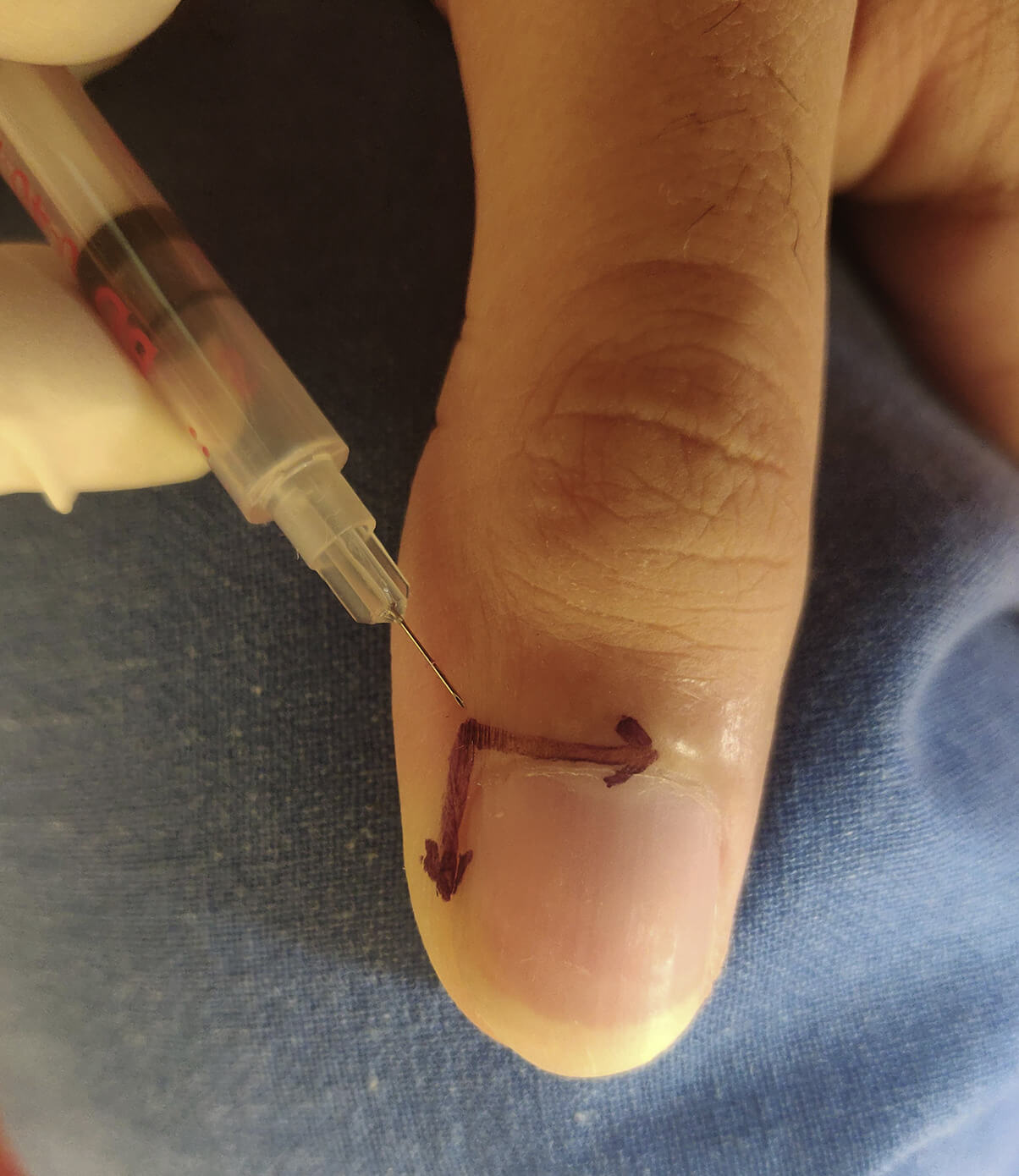
- Light therapy. Most applied is the treatment with topical PUVA. The nails are pre-treated with psoralen gel after which exposure to UVA light takes place. Typically between 30 and 40 treatments are required.
In addition to the drug therapies mentioned, there are other treatment options. In practice, however, they are only used in individual cases. Therapies used include:
- Electrotherapy: Some doctors treat diseased nails with so-called interference currents.
- X-ray therapy: Specialized doctors also use X-rays in very rare cases. The affected nail is removed completely. The nail may also be removed by the application of a high concentration of urea or surgery.
- Lasers: Nail psoriasis treatment with laser beams, such as those known from eye lasers (excimer laser) or hair and tattoo removal (Nd-YAG laser) are sometimes used. There is not enough evidence, however, that these work well in treating nail psoriasis.
Systemic Therapies Used As Nail Psoriasis Treatments
Tablets. The tablets contain agents that slow down nail growth and/or slow down the immune response that is derailed in psoriasis. Examples are acitretin, cyclosporine, and methotrexate.
This treatment option is not used when psoriasis affects only the nails. The patient must already suffer from another form of psoriasis to qualify.
Treatment is long-term, at least 6 months and blood checks are necessary to monitor the health of internal organs such as the liver and kidneys. Nevertheless, good results are achieved.
Biological therapy. Biologics are modified body proteins (including antibodies, cytokines, and fusion proteins) that have been developed to target specific steps in the disrupted defense process in psoriasis.
The target tissue is a special group of white blood cells, the so-called T cells. There is some evidence that these T cells play a major role in psoriasis.
Biologicals can be used when the inhibitory tablets have failed.
The dosage form is by repeated injections or infusions. The most effective biologicals against nail psoriasis are infliximab, adalimumab, and etanercept. A lesser-known biological found to be very effective in nail psoriasis treatment is ustekinumab.
Nail Psoriasis Home Remedies
Some sufferers rely on home remedies and medicinal plants to treat psoriatic nails. However, the effect is often not medically guaranteed.
The following home remedies and medicinal plants primarily help with psoriasis and can therefore also be used for nail psoriasis. They are supposed to counteract the inflammatory processes and, for example, relieve itching, redness, and flaking.
- Aloe vera
- Capsaicin (from chili peppers)
- Indigo Naturalis as an extract in oil (applied externally, study shows benefit)
- Healing earth pads
- Oregon grape creams and ointments
- Wheat and oat bran baths
- Tea tree oil (applied externally)
- Evening primrose oil (applied externally)
- Almond oil (applied externally)
- Black tea pads and compresses
- Milk thistle tea pads and compresses
- Pansy tea pads and compresses
- Quark wraps, packs, or rubbings
- Marigold ointment for nail bed inflammation
- Chamomile extract for nail bed inflammation
Home remedies and medicinal plants alone are not enough to successfully treat nail psoriasis. Therefore, seek advice from a dermatologist and discuss the right therapy with him.
How to Prevent Nail Psoriasis
- Avoid trauma to the nails (e.g. injury with a hammer, slamming a door closed on your nails, etc). This can make the abnormalities worse.
- Keep nails short and moisturize cuticles and nails regularly
- Do not try to remove anything under the nails with sharp objects (such as scissors or knives)
- Buff nails to keep them smooth
- Do not wear artificial nails
- Do not bite your nails
- Wear gloves to protect your nails whenever you work with your hands both inside and outside the house
- Protect toenails by wearing shoes that fit comfortably with sufficient room for the toes
Conclusion
Left untreated, nail psoriasis can lead to pain, swelling, and inflammatory reactions in the fingers and toes, sometimes so bad that they can become deformed.
Early initiation of therapy is therefore important. However, the results are not always good and the abnormalities may return once treatment is stopped.
